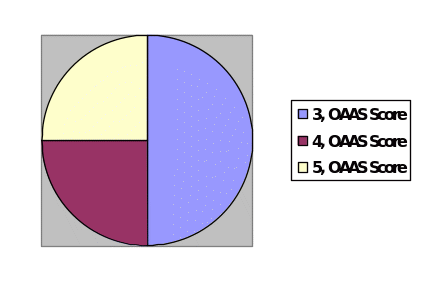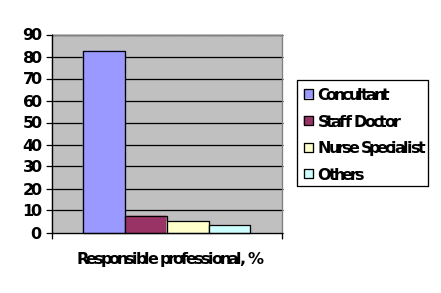Introduction
The identification of trends and gaps in available data is a vital part of the project implementation because it may be necessary to modify the approach depending on the situation. Risks are always present, and it would be reasonable to minimize them to avoid possible complications. The data related to a similar project in another organization has been collected and analyzed. Furthermore, it is necessary to review the findings and determine if particular connections are present. Such information is vital, and should be considered during the development of the strategy.
Results and Trends
Demands of Clients
The most important trend that affects nearly all the areas of healthcare is the focus on the needs of the patient. Moreover, numerous factors should be taken into account, and every individual may require a unique approach. Data that was received as a result of the analysis of peer-reviewed articles on this topic suggests that such aspects as fear and anxiety related to radiological procedures must be managed. Health professionals did not view this factor as critical in the past, but the industry has gone through numerous changes, and satisfaction levels of patients are of utmost importance nowadays. Therefore, this can be described as a particular trend because it has been recognized that the process can be quite stressful for an individual (Huffman & Haas, 2014). The treatment is also affected by the age of the patient. The process is quite problematic when it comes to children because various factors affect their behavior. The lack of knowledge is noted as especially problematic, and should be addressed (Baxter, 2012). The issue is that it would be necessary to utilize more resources on the development of leaflets, and it would be important to determine their level of efficiency. Moreover, it has been noted that the biggest number of patients that are in need of conscious sedation are in the age group from sixty-one to ninety (South West Anesthetic Research Matrix, 2015). This factor should not be disregarded, and it would be appropriate to train nurses that specialize in geriatrics.
Innovations
Another trend worth discussing is an increase in the utilization of modern technologies. They are vital in modern healthcare, and help to reduce work overload. Nurses have many tasks and responsibilities, and such techniques as patient-maintained sedation may be considered. However, the biggest problem is that associated risks are quite severe, and patients may not be aware of when unsafe levels are reached. One of the studies has shown that the addition of a reaction-time method makes the process much safer (Allam et al., 2013). Such numbers are intriguing, but the fact that results vary from individual to individual should be considered (see Figure 1).

It can be seen that the biggest number of individuals have reached the safest levels. However, the sample size was rather small, and it is an opportunity for further research. The technique has enormous potential, and would help to make the process much easier. Also, it would require additional training, and it could be a problem because the facility has limited amounts of resources. Most healthcare facilities are focused on the minimization of unnecessary expenses, and this trend has affected all the areas. Procedures that are not effective are replaced with new ones quite often.
Training and Knowledge
Another trend that can be tracked is that the role of nurses when it comes to conscious sedation has been steady increasing. However, the fact that they were previously underutilized is a significant issue because they lack the necessary training and experience. One of the studies has examined particular aspects of such practice in six hospitals in the United Kingdom, but researchers recognized that it had several limitations (South West Anesthetic Research Matrix, 2015). It can be seen that the number of nurse professionals that are focused on such procedures is relatively small (see Figure 2)

Such results are quite intriguing, and should be acknowledged. The experience of others countries needs to be analyzed. Another trend that should be mentioned is an increased focus on cooperation in healthcare. Furthermore, this is an enormous risk for the medical center because nurses could lack experience in this area, and are not aware of what aspects should be prioritized. Such interactions are crucial, and any gaps in knowledge should be avoided because it could complicate the situation (Olsen, Barger, & Doshi, 2013). The amount of knowledge that such procedures require is enormous, and all possible events should not be overlooked (Reekers, 2015). Every professional must be aware of what measures should be taken in case complications are introduced (see Table 1).
Table 1. Unplanned events.
It is necessary to understand that other issues are also possible. Health-care professionals should be competent and qualified. Also, necessary tools and instruments should also be available because the health and well-being of the patient are at risk. The issue is that many health professionals believe that current methods utilized to determine the level of sedation are not efficient, and should be improved.
Summary
Such aspects as an increase in demands on patients and insufficient levels of knowledge among nurses can be incredibly problematic, and should be addressed to avoid issues with scheduling. Expectations of clients are set extremely high, and healthcare professionals should focus on lifelong learning to stay competent. Modern technologies utilized are much more often, and their primary aim is to increase the level of efficiency of operations.
Interpretation
It is evident that current trend could complicate the implementation of proposed project. Therefore, it would be reasonable to review peer-reviewed articles and literature focused on this subject matter to be aware of current developments. This approach would help to get a better understanding of what alterations to the strategy may be needed to ensure that the project is successful. Overall, the most attention should be devoted to training, and nurses should be provided with all the required information on this subject matter because the risk of regression is quite significant.
Interference and Gaps
Particular gaps in knowledge should not be overlooked, and it would be reasonable to evaluate if the medical center has specialists that would be capable of monitoring the whole process. Additionally, it is critical to determine the percentage of RNs that had previous experience with conscious sedation at the medical center. The problem is that it is not clear if some of the trends are also present in the United States, and it would be beneficial to conduct additional research.
New Information
Scholars have focused on the modification of such techniques, and many ideas suggested are quite comprehensive, and it could affect the project because pieces of training can be perceived as not sufficient if new methods are introduced. New policies and government regulations may complicate the process, and they should be reviewed. The information regarding the financial situation in the healthcare facility is likely to have an impact on the whole process of implementation.
References
Allam, S., Anderson, K. J., O’Brien, C., Macpherson, J. A., Gambhir, S., Leitch, J. A., & Kenny, G. C. (2013). Patient-maintained propofol sedation using reaction time monitoring: a volunteer safety study. Anaesthesia, 68(2), 154-158.
Baxter, A. L. (2012). Best practices for outpatient procedural sedation. Pediatric Annals, 41(11), 471-475.
Huffman, J., & Haas, R. E. (2014). The safe and effective use of pharmacological agents used for sedation during radiological procedures. Journal of Radiology Nursing, 33(3), 132-144.
Olsen, J. W., Barger, R. L., & Doshi, S. K. (2013). Moderate sedation: What radiologists need to know. American Journal of Roentgenology, 201(5), 941-946.
Reekers, J. (2015). Basic clinical requirements of interventional radiology. In A. M. Belli, M. J. Lee, & A. Adam (Eds.), Grainger & Allison’s diagnostic radiology: Interventional imaging (pp. 1-4). New York, NY: Elsevier Health Sciences.
South West Anesthetic Research Matrix (2015). Sedation practice in six acute hospitals – A snapshot survey. Anaesthesia, 70(4), 407-415.